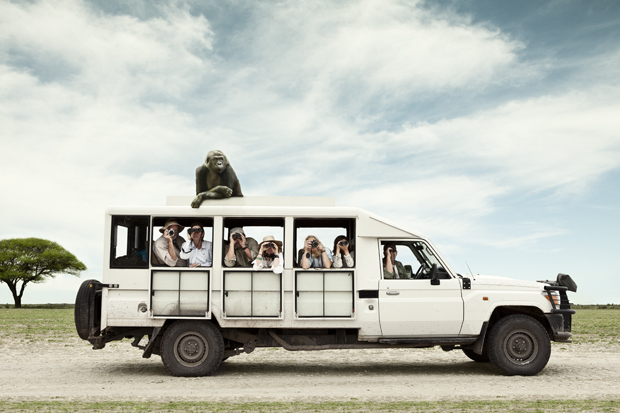Zack Seckler is a New York based award-winning photographer who turned to fine art photography, and then worked with Harper’s BAZAAR, Marie Claire and New York Magazine as well as commercial clients such as Gap, Samsung and Starbucks. Seckler has an eye for mind blowing imagery that can sometimes be extremely ironic and funny. In addition to that, he took a trip to the Kalahari basin in order to create ‘Botswana’, a breathtaking aerial series iconic African landscapes.
How would you describe your work?
Some class it as “quirky”. It’s a combinationof media. I do use quite a bit of photoshop, though in other cases the images are as photographed and there’s no photoshop. Sometimes each part of the photo is shot separately. Regarding the part of what people think of my photographs, I don’t like to categorize it myself, because I feel each shot is unique- therefore I am ok with any opinion. There is always a different approach, a different message or idea. I tend to gravitate towards dry humor and often certain tragic elements within that. My goal is to show a world that most people couldn’t think of. A lot of it is unexpected, everyday situations presented in an unfamiliar manner.
Your “Humor” “collection of photographs is indeed hilarious and realistic. Is humor the best way to tell the truth without being rude?
In some cases yes. When you create humor around uncertainty, it allows for people to put forward their own impression of your work. I’ve had people think that my imagery is about social messages regarding the environment and the future of the earth. It’s not so concrete. I like to take photographs that are slightly open to interpretation. Something that is very obvious does not seem that interesting to me. I may not have a specific social message in mind, but while capturing the moment I find ways to trigger emotions through something weird or hilarious. I’m glad my images make people wonder about my intentions. It’s nice that the images have a life of their own.
What would be the perfect landscape for you to photograph?
I’ve been very fortunate to have visited many different environments on this planet and see amazing places, but the one thing that I always gravitate towards is very clean environments as a basis. I enjoy desert locations. A wide open space includes as little as possible with very little visual clutter, so whatever I add to that environment leaves an impression. Sometimes when I‘m shooting in a more “noisy” environment I’m always thinking of the things I have to remove. In a desert environment it all works out, while having a clear visual consciousness.
Your ‘Botswana’ series consists of stunning, breathtaking aerial photographs taken while flying near ground level. Tell us a few things about this unique experience.
I was in this tiny ultra-light aircraft only big enough for two people, with no doors and no windows. It was basically a windshield, two seatbelts and a propeller. I took several flights over this massive salt flat in Botswana and then I took a couple of more flights in a slightly bigger aircraft over a delta. These two environments were the absolute opposite of each other. The delta is lush and filled with vegetation, while the salt flat was a mixture of dry mud that created interesting colors when it was clogged with rain water. What was really special about that project was the ability to see the landscape from such a distance.
NELLY SKOUFATOGLOU






